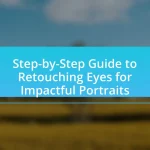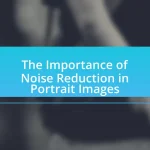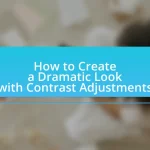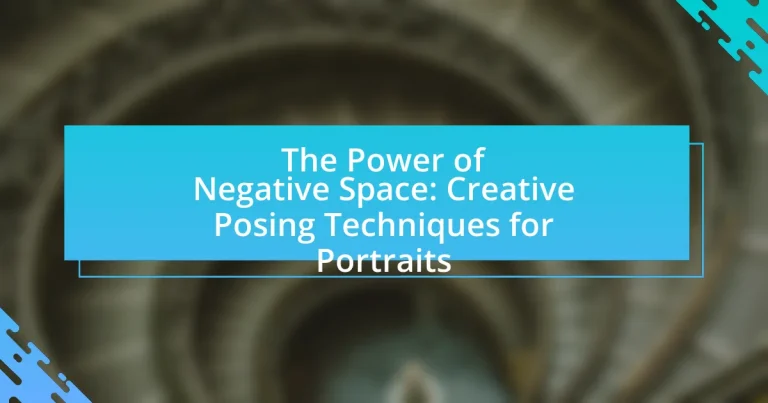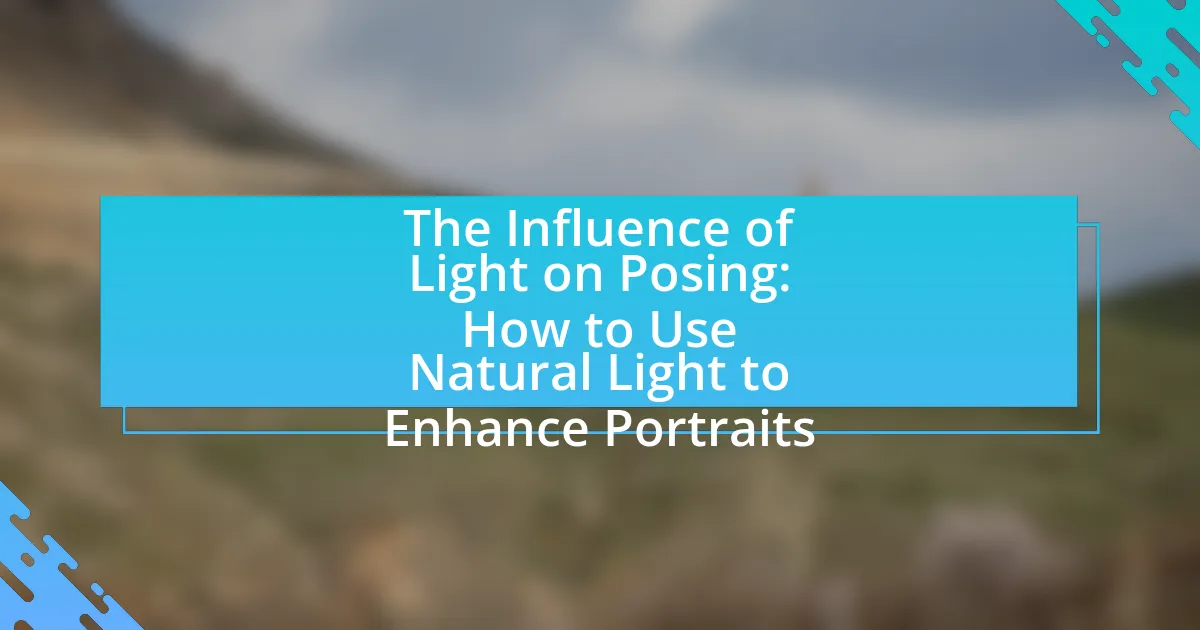The article focuses on the significance of negative space in portrait photography, emphasizing its role in enhancing the subject’s visibility and emotional impact. It explores how negative space influences composition, directs viewer attention, and contributes to storytelling by creating a visual context that evokes various emotions. The article also outlines creative posing techniques that utilize negative space, discusses common mistakes to avoid, and provides practical tips for photographers to master this technique, ultimately highlighting the importance of negative space in achieving aesthetically pleasing and engaging portraits.
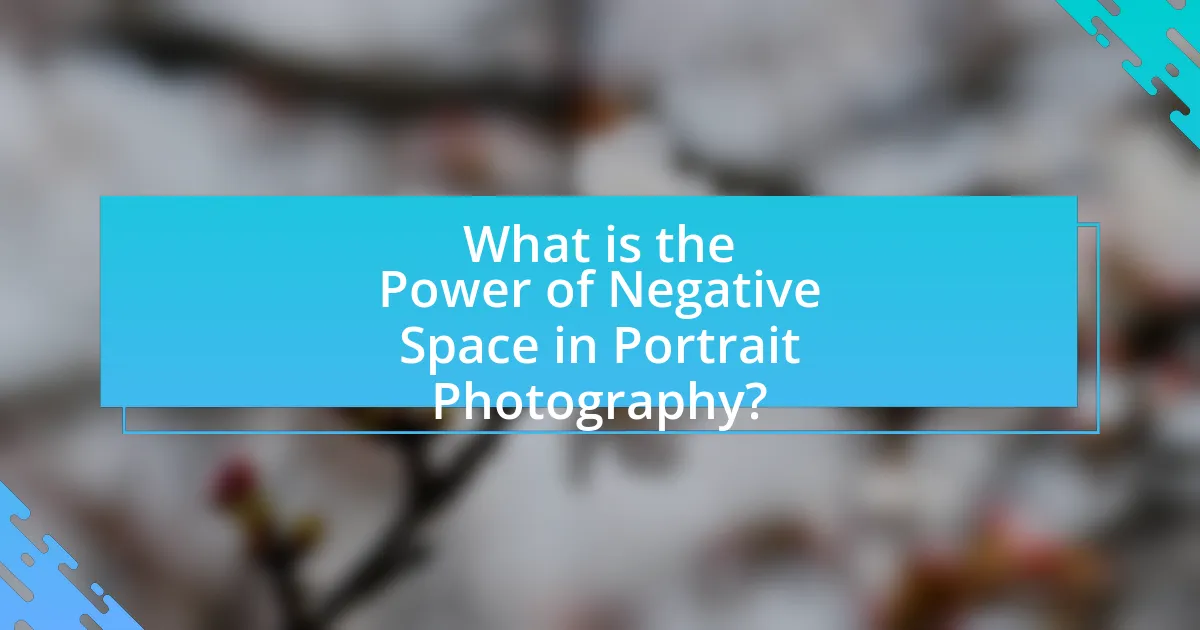
What is the Power of Negative Space in Portrait Photography?
The power of negative space in portrait photography lies in its ability to enhance the subject by creating a sense of balance and focus. Negative space refers to the area surrounding the main subject, which can draw attention to the subject and evoke emotions. By strategically using negative space, photographers can simplify compositions, emphasize the subject’s features, and create a more impactful visual narrative. Studies in visual perception indicate that images with effective use of negative space are often perceived as more aesthetically pleasing, as they allow the viewer’s eye to rest and engage with the subject more fully.
How does negative space influence the composition of a portrait?
Negative space significantly influences the composition of a portrait by enhancing the subject’s visibility and emotional impact. By strategically using empty areas around the subject, artists can draw attention to the focal point, creating a sense of balance and harmony. For instance, a portrait with ample negative space can evoke feelings of isolation or contemplation, as seen in the works of photographers like Richard Avedon, who often employed negative space to emphasize the subject’s expression and presence. This technique not only guides the viewer’s eye but also contributes to the overall narrative of the portrait, making it a powerful tool in visual storytelling.
What are the visual effects of negative space in portraiture?
Negative space in portraiture enhances the visual impact by creating balance and drawing attention to the subject. This technique allows the viewer’s eye to focus on the main subject while the surrounding empty space provides context and emotional resonance. Research indicates that effective use of negative space can evoke feelings of isolation or tranquility, depending on the composition. For instance, a portrait with ample negative space can convey a sense of calmness, while a tighter composition may suggest tension or intimacy. This manipulation of space is crucial in guiding viewer perception and emotional response, making it a powerful tool in portrait photography.
How can negative space enhance the subject’s presence in a photo?
Negative space enhances the subject’s presence in a photo by creating a visual contrast that draws attention to the subject. This technique allows the viewer’s eye to focus on the main subject without distractions, emphasizing its importance within the composition. For instance, when a subject is surrounded by ample negative space, it can evoke feelings of isolation or highlight the subject’s emotions, making the image more impactful. Studies in visual perception indicate that images with effective use of negative space are often more engaging, as they guide the viewer’s gaze and create a sense of balance.
Why is negative space important for creative posing techniques?
Negative space is crucial for creative posing techniques because it enhances composition and draws attention to the subject. By strategically using negative space, photographers can create a sense of balance and focus, allowing the viewer’s eye to be directed towards the main subject without distractions. This technique is supported by principles of design, where negative space can evoke emotions and convey messages more effectively. For instance, a study published in the Journal of Visual Communication found that images utilizing negative space are perceived as more aesthetically pleasing and engaging, reinforcing the importance of this technique in portrait photography.
How does negative space contribute to storytelling in portraits?
Negative space enhances storytelling in portraits by creating a visual context that emphasizes the subject and conveys emotions or themes. By strategically using empty areas around the subject, photographers can guide the viewer’s focus, evoke feelings of isolation or connection, and suggest narratives beyond the immediate scene. For instance, a portrait with significant negative space can imply solitude or introspection, while a tighter composition may suggest intimacy or urgency. This technique is supported by principles of design, where balance and contrast play crucial roles in visual storytelling, making the subject’s expression and posture more impactful.
What role does negative space play in directing viewer attention?
Negative space plays a crucial role in directing viewer attention by creating a visual balance that emphasizes the main subject of a composition. By strategically using empty areas around the subject, artists and photographers can guide the viewer’s eye to focus on the intended focal point, enhancing the overall impact of the image. Research in visual perception indicates that negative space can reduce distractions, allowing the viewer to engage more deeply with the subject, as evidenced by studies showing that compositions with effective negative space are often perceived as more aesthetically pleasing and easier to interpret.

What are Creative Posing Techniques that Utilize Negative Space?
Creative posing techniques that utilize negative space include framing subjects with surrounding elements, using asymmetry to draw attention, and incorporating open areas to enhance emotional impact. For instance, placing a subject off-center allows the surrounding space to create a sense of balance and focus, effectively guiding the viewer’s eye. Additionally, using natural elements like trees or architecture can create interesting silhouettes that emphasize the subject while highlighting the negative space. These techniques are supported by principles of composition in photography, which suggest that negative space can enhance storytelling and visual interest in portraits.
How can photographers effectively use negative space in posing?
Photographers can effectively use negative space in posing by strategically placing the subject within a minimalistic background to enhance focus and create visual balance. This technique allows the subject to stand out, drawing the viewer’s attention while the surrounding empty space contributes to the overall composition. For instance, utilizing a large area of sky or a plain wall can emphasize the subject’s features and expressions, making the portrait more impactful. Studies in visual perception indicate that images with significant negative space can evoke stronger emotional responses, as they guide the viewer’s gaze and create a sense of tranquility.
What are some examples of poses that create effective negative space?
Examples of poses that create effective negative space include the “arms raised” pose, where the subject lifts their arms above their head, creating a silhouette against the background. Another example is the “leaning” pose, where the subject leans against a wall or object, allowing for open space around them, enhancing the composition. Additionally, the “sitting with legs extended” pose generates negative space by positioning the legs apart, which draws attention to the subject while emphasizing the surrounding area. These poses effectively utilize negative space to enhance visual interest and balance in portrait photography.
How can angles and framing enhance negative space in portraits?
Angles and framing can significantly enhance negative space in portraits by directing the viewer’s attention and creating a sense of balance. Utilizing low or high angles can alter the perception of the subject within the frame, allowing for more negative space around the subject, which emphasizes their presence. For instance, shooting from a low angle can make the subject appear more dominant against a vast background, while high angles can create a feeling of vulnerability, both of which utilize negative space effectively. Additionally, framing techniques such as using natural elements or architectural features can isolate the subject, further enhancing the negative space and drawing focus to the subject’s expression or pose. This approach aligns with compositional principles that suggest negative space can evoke emotions and create visual interest, as supported by studies in visual perception that highlight the importance of space in guiding viewer engagement.
What are the common mistakes to avoid when using negative space in posing?
Common mistakes to avoid when using negative space in posing include overcrowding the frame, neglecting the subject’s placement, and failing to consider the background. Overcrowding the frame can dilute the impact of negative space, making the composition feel cluttered. Proper subject placement is crucial; placing the subject too centrally can eliminate the intended effect of negative space, which is to draw attention to the subject through contrast. Additionally, ignoring the background can lead to distractions that undermine the overall composition. These mistakes can diminish the effectiveness of negative space, which is meant to enhance the visual narrative in portrait photography.
How can improper use of negative space detract from a portrait?
Improper use of negative space can detract from a portrait by creating visual imbalance and distracting the viewer from the subject. When negative space is not effectively utilized, it can lead to a cluttered composition that overwhelms the focal point, making it difficult for the audience to engage with the subject. For instance, excessive or poorly placed negative space can draw attention away from the subject’s facial expressions or body language, which are crucial for conveying emotion and narrative in portraiture. This mismanagement of space can result in a lack of harmony and focus, ultimately diminishing the overall impact of the portrait.
What are the signs of ineffective negative space in a photograph?
Ineffective negative space in a photograph is indicated by cluttered backgrounds that distract from the main subject. When the negative space fails to enhance the subject, it can create confusion and diminish the overall impact of the image. Additionally, if the negative space is poorly balanced or disproportionate, it can lead to a lack of harmony, making the photograph feel unintentional or chaotic. Effective negative space should guide the viewer’s eye toward the subject, while ineffective negative space often results in a disjointed composition that does not support the intended message or emotion of the photograph.
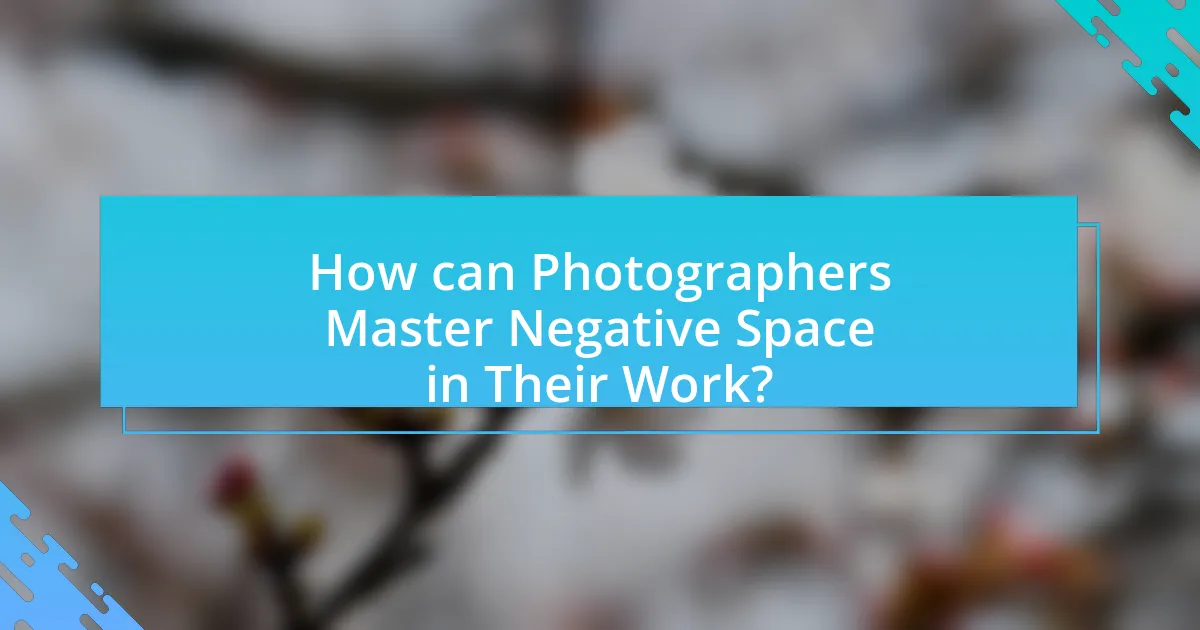
How can Photographers Master Negative Space in Their Work?
Photographers can master negative space by intentionally incorporating it into their compositions to enhance the subject’s prominence. This technique involves leaving ample empty space around the main subject, which draws the viewer’s attention and creates a sense of balance. For instance, using a wide aperture can blur the background, emphasizing the subject while utilizing the surrounding space effectively. Studies in visual perception indicate that images with well-defined negative space are more engaging, as they guide the viewer’s eye and evoke emotional responses. By practicing this approach, photographers can create striking images that leverage negative space to convey depth and narrative.
What techniques can be employed to improve the use of negative space?
To improve the use of negative space in portrait photography, photographers can employ techniques such as framing, contrast, and simplification. Framing involves using elements within the scene to create a border around the subject, enhancing the perception of negative space. Contrast can be achieved by placing the subject against a plain or contrasting background, making the negative space more pronounced. Simplification focuses on reducing clutter in the composition, allowing the negative space to draw attention to the subject effectively. These techniques are supported by principles of design that emphasize balance and focus, which are crucial for creating impactful images.
How can lighting affect the perception of negative space in portraits?
Lighting significantly influences the perception of negative space in portraits by altering the visibility and contrast of the background relative to the subject. When lighting is directed strategically, it can enhance the separation between the subject and the negative space, making the latter appear more pronounced or subdued. For instance, high-contrast lighting can create sharp shadows that define the edges of the subject, thereby emphasizing the surrounding negative space. Conversely, soft lighting can blend the subject into the background, reducing the impact of negative space. Studies in photography demonstrate that the manipulation of light can change the viewer’s focus and emotional response, highlighting the importance of lighting in composition.
What tools and resources can assist in mastering negative space?
To master negative space, photographers can utilize tools such as composition apps like Adobe Lightroom and Snapseed, which allow for precise cropping and framing to enhance negative space. Additionally, resources like online courses from platforms such as Skillshare and Udemy offer structured lessons on composition techniques, including negative space. Books like “The Photographer’s Eye” by Michael Freeman provide in-depth insights into visual composition, emphasizing the importance of negative space in creating impactful images. These tools and resources collectively support the understanding and application of negative space in portrait photography.
What practical tips can photographers follow to enhance their portraits using negative space?
Photographers can enhance their portraits using negative space by intentionally incorporating empty areas around the subject to draw attention and create a sense of balance. To achieve this, photographers should position their subjects off-center, utilizing the rule of thirds, which suggests placing the subject along the intersecting lines of a grid to create a more dynamic composition. Additionally, they can use wide apertures to blur the background, emphasizing the subject while allowing negative space to frame them effectively.
Research indicates that images with effective use of negative space can evoke stronger emotional responses, as seen in studies on visual perception and composition. By consciously leaving areas of the frame unoccupied, photographers can guide the viewer’s eye and enhance the overall impact of the portrait.
How can experimenting with different compositions improve skills in negative space?
Experimenting with different compositions enhances skills in negative space by allowing artists to understand how the arrangement of elements affects visual balance and focus. By manipulating the placement of subjects and backgrounds, artists can learn to create intentional voids that draw attention to the main subject, thereby improving their ability to utilize negative space effectively. Studies in visual perception indicate that viewers are more likely to engage with images that have a clear distinction between positive and negative space, reinforcing the importance of composition in artistic practice.
What are the best practices for incorporating negative space into portrait sessions?
The best practices for incorporating negative space into portrait sessions include strategically positioning the subject within the frame to create balance and emphasize the subject’s presence. Photographers should utilize wide apertures to blur the background, enhancing the negative space effect, and consider the rule of thirds to guide composition. Additionally, leaving ample space around the subject can evoke emotions and draw attention to the subject’s expression or pose. Research indicates that effective use of negative space can lead to more engaging and visually appealing portraits, as it allows the viewer’s eye to focus on the subject without distractions.




